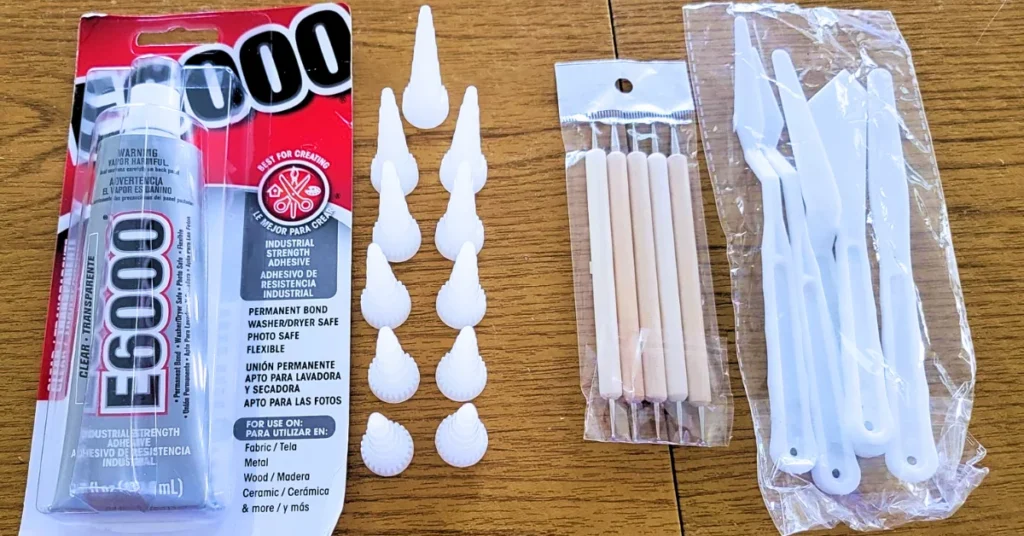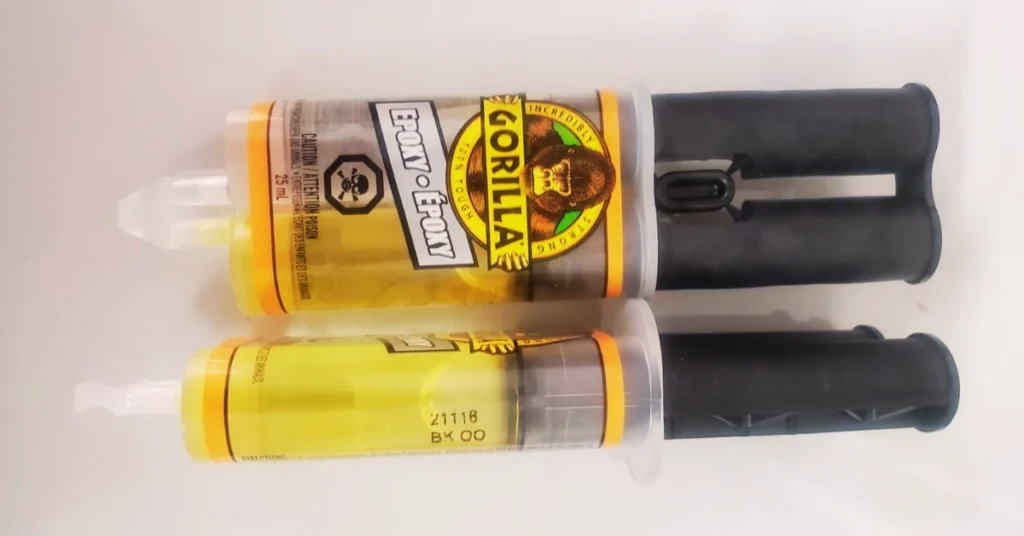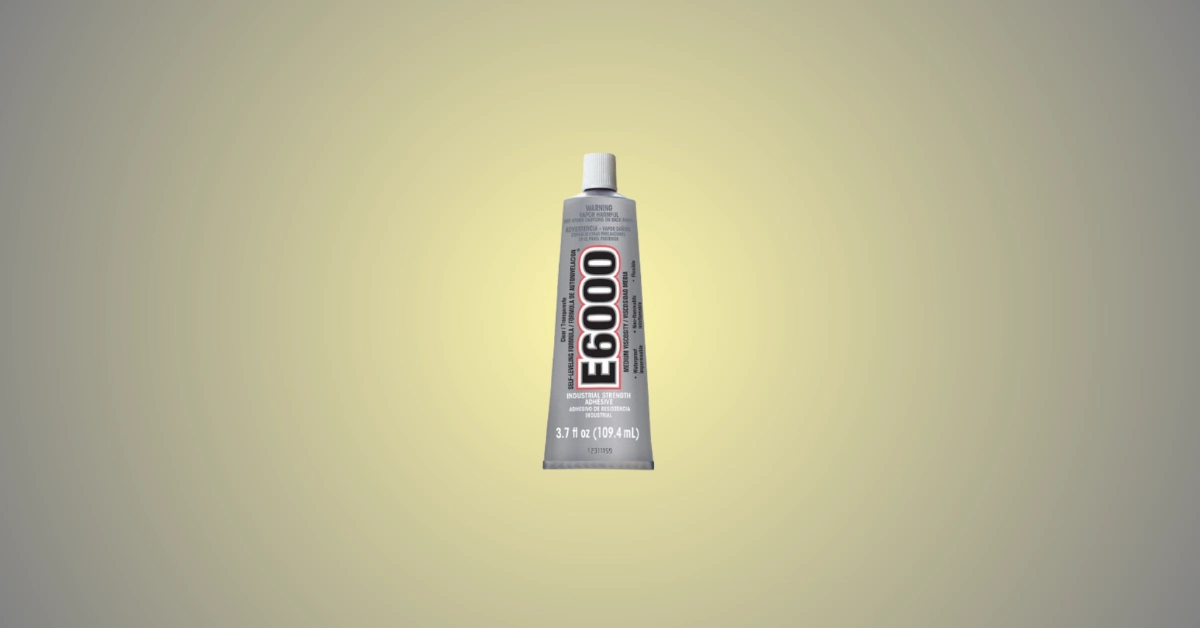E6000 is an industrial-strength, versatile adhesive suitable for many projects. It is great for woodworking, leatherworking, arts and crafts, and more.
Epoxy glues are multipurpose, forming a strong, durable bond. It is used for electrical components, electronics, aerospace, arts and biology, and more.
Both are good but different. So, it’s important to compare them to choose the proper one for your project.
Article Highlights
- E6000 is an industrial-strength, versatile craft glue suitable for indoor and outdoor projects.
- Epoxy glues are good for flexible, rigid, and durable bonds.
- E6000 is non-brittle, but epoxy glues can be brittle without modification.
- E6000 is waterproof, heat, flame, and chemical resistant.
E6000 vs. Epoxy Glue
E6000 is an industrial-strength, heavy-duty adhesive that effectively adheres to most materials. This craft glue can also be applied to high-wear areas.
E6000 glue is known for its exceptional strength, durability, toughness, and flexibility.
It is flexible but doesn’t get brittle or break down under stress and extreme temperatures. The E6000 is suitable for providing high-strength performance.
On the other hand, epoxy glues are epoxy resins. Many brands, such as Gorilla, Araldite, Devcon epoxy, create strong epoxy glues.
Epoxy is a thermosetting adhesive that is made of resin and hardener. It can be used on multiple surfaces and provides solid and permanent bonds.
Also, the strong bond can provide extreme stress and tolerance to weather conditions. Epoxy glues are widely used for many applications.
It is the most adaptable structural adhesive that can fulfill specific requirements for every project.

Strength And Performance
E6000 has great flexibility. It’s stretchy but does not break down under stress.
It is also a low-odor, acid-free, and photo-safe adhesive with a shelf life of 2 years. Within minutes, it creates an extremely strong, challenging, and permanent bond.
The flexible bond doesn’t crack, yellow, or brittle at extreme temperatures.
E6000 glue is paintable, dries clear, and is washer/dryer safe, making it versatile for multiple uses.
On the other hand, epoxy glues can also provide tough and flexible bonds that perform better in impact and thermal shock.
Epoxy resin has strong structural properties and is compact and easy to use.
It has excellent bonding strength and is flexible enough. The shrinkage during curing is minimal, and the internal tension is comparatively small.
Moreover, the electrical performance is excellent. With great usability and stability, epoxy glues are versatile enough for many jobs and repairs.
Cure Color
E6000 is transparent and dries clear. It is an industrial-strength adhesive that becomes non-flammable once cured.
Epoxy glues also come in transparent colors for most usability and versatility.
Compatible Materials
E6000 is compatible with wood, metal, ceramic, glass, fiberglass, concrete, fabric, masonry, and more.
It can also create strong bonds with rubber, vinyl, leather, and many plastics.
Conversely, epoxy glues are considered the most versatile. They are suitable for bonding metal, wood, glass, fiberglass, ceramic, concrete, and many plastics.
E6000 and epoxy glues are both excellent in their own ways. But what about E6000 vs. Krazy Glue, or E6000 vs. J-B Weld?
Applications
E6000 is excellent for woodworking, leatherworking, arts and crafts projects, jewelry, furniture, and other repairs.
Epoxy glues are often used in industrial and automotive applications.
They are used for industrial tooling, composites, fixtures, castings, laminates, and other industrial product properties.
It also has wind turbine technology and can be used for electrical systems, electronics, petroleum, petrochemicals, aerospace, construction applications, consumer, marine, biology, art, and more.
It’s also suitable for paints and coating, which makes it versatile.
Temperature
E6000 is an indoor/outdoor adhesive that withstands temperatures from -40 to 180 °F (10 to 32 °C).
The best part is that it doesn’t break down or become brittle in high temperatures. So, it’s suitable for bonding everything and creating anything.
Epoxy glues have thermal stability and have a compatible temperature between 185 to 200°C.

Resistance And Benefits
E6000 is a flexible glue. It is photo-safe and washer/dryer-safe.
Also, E6000 glue is waterproof, so it is suitable for both indoor and outdoor applications. It provides permanent repair, great strength, and versatility. It is non-brittle, which is a plus.
Epoxy adhesives are heat, flame, and chemical resistant. They also have excellent tensile strength and creep resistance, better than brittle and rigid adhesives.
So, E6000 is a flexible glue. Wondering how its resistance compares to others? Read E6000 vs. E6000 Plus or E6000 vs. E8000 Glue.
Drawbacks
E6000 has no UV resistance and no solvent-free features.
Conversely, epoxy glue’s drawbacks are that it can be brittle without adjustment, unlike E6000, and the ingredients of epoxy glue can be hazardous to work with.
Moreover, it takes a long time to cure. For a proper curing facility, you need to mix the two-part epoxy in an exact ratio.
Caution
E6000 is vapor harmful. It contains perchloroethylene, which is the cause of cancer. Also, it can cause eye and skin irritation.
Prolonged exposure to vapor can cause eye irritation, headache, dizziness, nausea, and more.
So, you must avoid inhalation and use an exhaust fan to remove vapor.
Further, avoid skin and eye contact and wash hands immediately after every use. Rinse off the eyes with plenty of water if there is eye contact.
On the other hand, prolonged use of epoxy glue can create allergic reactions. Epoxy is the primary source of occupational asthma. That’s why safe disposal is crucial.
Furthermore, epoxy glues irritate the eyes and skin and are toxic to aquatic organisms. Solid epoxies are safer than liquid resins.
Editor’s Note
E6000 and epoxy glues are both excellent in their own ways. However, epoxy is more versatile and suitable for many projects.
Epoxy glues are good for arts, crafts, jewelry, aerospace, industrial components, electrical and electronics use, and lots more.
E6000 is suitable for woodworking, leatherworking, arts and crafts, and more. It can be used for both indoor and outdoor projects.
I think epoxy glue is more suitable than E6000 glue because of its excellent multipurpose properties.
However, the E6000 is better for outdoor and waterproof projects.


